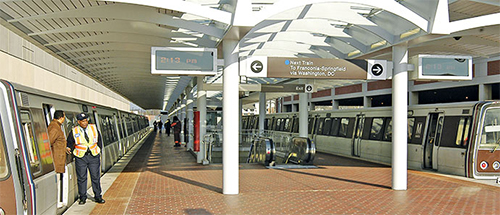As acronyms go, they don’t come much grander than MGM.
If you’re in the nation’s capital, however (aka the capital of acronyms), then FBI comes mighty close.
Both are front and center in PGC — Prince George’s County, Md., that is.
After a year-long competitive bid process, MGM National Harbor, a subsidiary of Las Vegas–based MGM Resorts International, in December 2013 was awarded the license to operate the sixth casino in the state. MGM’s new $925-million resort and casino will land in one of the region’s premier waterside mixed-use developments, National Harbor, on the banks of the Potomac River. MGM National Harbor will create more than 4,000 direct permanent jobs in National Harbor.
The company’s CEO and Chairman Jim Murren called the development a “gateway to Maryland.” MGM began 2014 by engaging a number of local firms. “There is no shortage of talent here in Prince George’s County,” said MGM National Harbor President and COO Lorenzo Creighton, “and we continue to be both confident and impressed with the talented team we’re putting together.”
National Harbor welcomed the opening of Tanger Outlets in November 2013. It was “the most successful Thanksgiving holiday opening they’ve ever experienced,” says David Iannucci, the county’s assistant deputy chief administrative officer for economic development and public infrastructure. National Harbor also has welcomed new office tenants: In December, federal contractor Spartan Business & Technology moved its 100 employees to new space there, and planned to add 62 more following an expected acquisition in 2014.
Walton Group’s 310-acre Westphalia Town Center broke ground in 2013 on 479 acres Walton purchased near Joint Base Andrews in 2012. Plans call for 5,000 housing units, 600 hotel rooms and around 6 million sq. feet of retail, commercial and office space at the project, all within a larger 6,000-acre Westphalia Sector that anticipates welcoming up to 10,000 new homes in the near future.
Time to Move
A potential headquarters move to the county from the FBI continues to be a priority for the county. The agency’s new home will house around 11,000 of its 35,000 worldwide employees. The front-running 82-acre site near the Greenbelt Metro rail transit station is under contract with Renard Development as part of a potential $2-billion development. A public rally early this year for securing the FBI HQ resounded with the chant, “We’re all in.”

Metro’s Largo Town Center station is one of five Metrorail stations targeted by Prince George’s County as high priority for transit-oriented development opportunities. The county is home to 15 Metro stations, many of them surrounded by land primed for development.
Photo courtesy of Metro
“We’re convinced it is the finest center for the FBI location in this area,” says Iannucci. Should that come to pass, he compares its significance “to the day in 1941 when FDR decided to put the Pentagon in Northern Virginia … It would transform the county.”
That site’s proximity to public transit conjures one more acronym prominent in Prince George’s County’s economic development lexicon: TOD, or transit-oriented development, is where the action is, particularly in the National Capital Region. The county has 15 Metrorail stops on four different lines. Five stops in particular as of spring 2014 are receiving special high-priority development emphasis from the county: Largo Town Center, New Carrollton, Prince George’s Plaza, Branch Avenue and Suitland.
The county is home to “more developable, high-quality and modestly priced land for TOD than any jurisdiction in the DC area,” says Iannucci.
The county’s ante? “Incentives, reduced fees, expedited processes, and a commitment to put infrastructure in place to make it faster, less costly and more profitable.” Up to $5 million in conditional grants will be available from the county’s incentive fund for qualifying TOD projects.
Signs of momentum already are arriving near one of those five high-priority Metro stops: Largo Town Center will be home to a new $645-million regional medical center. A site nearby, says Iannucci, is reserved for a new research center affiliated with the University of Maryland’s Baltimore and College Park campuses. It fits right in with the county’s focus on healthcare/biotech, one of four priority sectors in its new economic development strategy hatched in May 2013.
“There is no shortage of talent here in Prince George’s County.”
— Lorenzo Creighton, President and COO, MGM National Harbor
Another of those priority stops, New Carrollton, in April welcomed its own momentum driver, as ground was broken for Prince George’s County’s first state agency headquarters, for the Maryland Dept. of Housing and Community Development. Nearby, two residential towers with ground-floor retail are rising, part of a $165-million mixed-use development.
New District near ‘The District’
Where might all the shoppers come from? New high-tech companies, among others. In March 2014, the Prince George’s County Council unanimously approved legislation to create the new Prince George’s County Science and Technology Business District composed of the Greater Beltsville, College Park, Riverdale, Riverdale Park, Berwyn Heights and Greenbelt areas.
Such a designation simply underlines the powerful assets already present in the county: University of Maryland at College Park; M Square Research Park; Beltsville Agricultural Research Center; NASA-Goddard; U.S. Army Research Laboratory; and the planned Howard University Research Park.
Looking for a way to view all these assets at once? Yet another forthcoming landmark will offer the best glimpse yet.
The 175-ft., 42-gondola Capital Wheel soon will take its place at National Harbor and join the ranks of famous global observation wheels such as the London Eye. Peterson Companies Chairman and Principal Milt Peterson said it only adds to the growing cachet of National Harbor. Prince George’s County Executive Rushern L. Baker, III, echoed that sentiment in January:
“These types of attractions,” said Baker, “are why Prince George’s County is the ‘Place to Be.’ ”
This Investment Profile was prepared under the auspices of Prince George’s County Economic Development Corp. For more information, visit www.pgcedc.com or call 301-583-4650.
